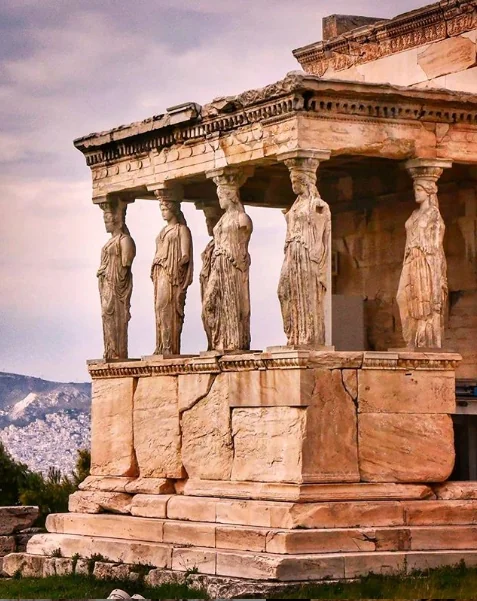
The Paternon, a temple dedicated to the goddess Athena, daughter of Zeus, and which gave the city its name. The Acropolis of ancient Greece means high cities and were built on the highest points of the city, originally serving as protection and were almost always surrounded by walls. Over the years they became civil or religious administrative headquarters.
Right at the entrance of Acropolis is what many historians believe to be the world’s first theatre. From this point onwards theatre and theatrical performances began. In the beginning the spectators sat on the floor of the hill and slowly wooden benches were built and finally a marble theatre. In the early years the theatre was just a ritual dedicated to the gods of entertainment, drink and wine. In the beginning it was people dressing like the followers of Dionysus, singing and dancing, but one day one of them went outside the group and started having a dialogue another group, that was the beginning of theatre, and this evolved into the theatre we have today.
To get to Athens, connections can be made from several European cities, such as Amsterdam, Paris, Madrid, Dubai and even Turkey. Walking around Athens is also like travelling back in time, a true open-air museum. At the top of the hill is the Acropolis, an area with buildings that pay tribute to the gods of Greek mythology.
The Acropolis of Ancient Greece

Athens-greece
The Paternon, a temple dedicated to the goddess Athena, daughter of Zeus, and which gave the city its name. The Acropolis of ancient Greece means high cities and were built on the highest points of the city, originally serving as protection and were almost always surrounded by walls. Over the years they became civil or religious administrative headquarters.
Right at the entrance of Acropolis is what many historians believe to be the world’s first theatre. From this point onwards theatre and theatrical performances began. In the beginning the spectators sat on the floor of the hill and slowly wooden benches were built and finally a marble theatre. In the early years the theatre was just a ritual dedicated to the gods of entertainment, drink and wine. In the beginning it was people dressing like the followers of Dionysus, singing and dancing, but one day one of them went outside the group and started having a dialogue another group, that was the beginning of theatre, and this evolved into the theatre we have today.
Every male citizen of Athens had the right to vote of make a suggestion, this is the exact place where democracy began.
The Temple of Athens: Parthenon

This building was built in the 5th century before Christ and that was in the early days of Athens. In early democracy Athens was a very powerful city, it was something like empire, and the most important thing about the Parthenon is not that the Athenians who would make such a beautiful, incredible, monumental temple that nobody had seen anything like it before!
To please the eyes of the spectators tricks like the golden ratio were used, everything follows the aura ratio in the Parthenon. It is the ratio of the ideal human body, if you observe in Da Vinci’s work, inside the circle the man is following the proportions, he possesses the aura ratio.
No matter how hard you look in the Parthenon, you will never find a straight line, straight lines do not exist in nature, and everything slightly goes towards the centre of the Parthenon.
From the top of Acropolis you can see the Temple of Zeus, who is the god of the gods.
Why aren’t there so many things and monuments in the Temple of Zeus?
The marble of the temple that was used to make a good quality work of art in recent years, but you can still see how great and monumental that time is. They started building in the 6th century before Christ and then there was a pause, then they resumed the work in the 4th century before Christ, and finally the Roman Emperor Hadrian finished the work in the 2nd century before Christ. It’s really a long story and it took hundreds of years for the work to be finished.
Why is the city called Athens?
Before the city was named Athens, two gods wanted to name it to be worshipped by the city, and they quarreled and competed. These gods said, “we will each give the city a gift and let it decide who will be the favourite god”. Then Poseidon, the god of the seas, struck the ground with his trident and salt water sprang up and Athena, the goddess of wisdom, struck her spear into the ground and an olive tree appeared and became the gift to the city.
Athena then won, and that’s why there are so many olive trees scattered around the city. And if she hadn’t won, the city would probably be called Poseidonia.
Both the Acropolis and the Parthenon were imperial buildings, something to show off how powerful, imposing and glorious the city is, that’s what they were built for.








